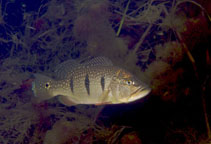| Family: |
Cichlidae (Cichlids), subfamily: Cichlinae |
| Max. size: |
61.7 cm SL (male/unsexed); max.weight: 6,220.0 g |
| Environment: |
benthopelagic; freshwater; pH range: 5.5 - 6.5 |
| Distribution: |
South America: Orinoco River basin, in tributaries of the Orinoco River in Colombia and Venezuela; Amazon River basin, in the Negro River basin, Brazil. |
| Diagnosis: |
Diagnosis: Differs from its congeners by typical presence of three large dark ocellated blotches along side, but occasionally blotches 2 and 3 irregularly developed or not ocellated. Lateral band abbreviated in juveniles. Differs from other species of Cichla with abbreviated juvenile lateral band by absence (vs. presence) of well defined vertical bars in adults; from ocellaris also by lateral line nearly always discontinuous vs. nearly always continuous, by absence (vs. presence) of bars 1a and 2a and absence (vs. presence) of abdominal blotches; from kelberi, monoculus, and pleiozona also by absence (vs. presence) of abdominal blotches and occipital bar, and presence (vs. absence) of postorbital markings; from nigromaculata also by absence (vs. presence) of bars 1a and 2a, and absence (vs. presence) of small black blotches on dorsum (Ref. 57716). |
| Biology: |
Inhabits rivers (Ref. 12251). Is usually captured in shallow near-shore areas of lagoons and slow moving reaches of the river channel. Feeds mainly on small characiform fish (Ref. 26329, 27531). |
| IUCN Red List Status: |
Least Concern (LC); Date assessed: 05 November 2020 Ref. (130435)
|
| Threat to humans: |
harmless |
| Country info: |
|
Source and more info: www.fishbase.org. For personal, classroom, and other internal use only. Not for publication.

